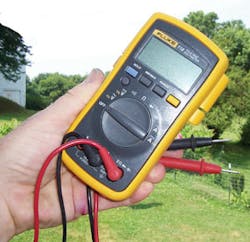We get a lot of questions from our readership at the Locksmith Ledger. That's great, because that's one of the reasons we're here. Your questions tell us what we're leaving out of our magazine, and whet topics and issues are on the minds of security professionals.
Unlike other trade publications, the editorial team here at the Ledger is comprised mostly of individuals with extensive experience in the field; managing locksmith businesses and actually performing the tasks and using the products we write about. We've been involved in the development of new lock and electronic products during different phases of our careers. At one point or another, we've been faced with a new product or system that has stopped us cold and forced us to learn.
So where do you start? Well, safety is first. This means the safety of your clients, then your own safety.
You should be able to move around any electronic system without creating a dangerous situation to your client. This means either an electrical hazard or a life safety hazard.
An electrical hazard might include the potential for electrical shock, or a fire caused by the system. A life safety hazard would be the disabling of a means of egress, lowering the security profile of a site or disabling an emergency warning system.
Next comes your own safety. This means understanding what you are working on enough so that you too can avoid electrical shocks, and creating and/or working in a hazardous environment.
An obvious precaution is: Do not work on "live" circuits. If you need a plant safety officer to know that you must shut off the circuit breaker before you handle line voltage, then you definitely need to get back to basics.
In most systems, there will be a line voltage side of the system and a low voltage side. You should first determine if this is the case, and then determine where the line voltage portion begins and ends, and where the low voltage portion begins and ends.
If you encounter a system that you suspect is all line voltage, unless you are a licensed electrician, simply leave it alone. Both legal and health liabilities are present in these situations.
Before you start, find the circuit breaker that provides voltage to the system you are working on and determine that it is indeed supplying power to your system. One way to do this is to simply ask your customer if they are sure the breaker (or receptacle) is working, and if they are not sure, that they find out. It's best to do this before you drive to the site.
Some systems are powered through receptacles, while others are "hard-wired." Testing the receptacle can be accomplished with a simple tester available for under $10. These basic go-no-go testers will tell you if there is voltage on the receptacle, and also if the receptacle is properly wired and grounded.
If the tester indicates either a miswire or a ground fault, tell your customer and pack up your tent until the issue is resolved.
Hard-wired systems generally will be one of two types. One type is a step-down transformer bolted to an electrical box. These are commonly used for intercom and door opener systems.
The other variation is the line voltage wires are brought into a metal enclosure, and connected to a terminal strip clearly marked to indicate that it is the LINE VOLTAGE. Hopefully there will be an insulated cover over these terminals, and the terminal strip will be located away from the low voltage terminals in the cabinet.
You'll need a meter
Recently I attended a product seminar conducted by one of the national security groups. While distributing the demo units, the instructor held up the cheap credit card-sized digital tester and pronounced that this was all you needed, and not to waste money on an "expensive" tester. This was bad advice.
What's a good tester? My definition is one which is properly insulated, is able to measure accurately, and that has ability to test a few different electrical characteristics: namely AC/DC Voltage, Resistance (OHMS) and Current (AMPS). Don't get a meter that will fit in your wallet.
My meter has passed several drop tests from various heights (ladders), passed the submersion test in service station toilet, the solvent test when I got a little wild with an aerosol, and a shock test. My meter even found it's way back to me when I carelessly left it behind at a job, like my old faithful hound Rex.
Equipped with a meter, you can then proceed to the next step: determining if the system is actually getting voltage. All line voltage is Alternating Current, universally referred to as AC Line Voltage. Look for part two of this article in next month's Locksmith Ledger.
Tim O'Leary
Tim O'Leary is a security consultant, trainer and technician who has also been writing articles on all areas of locksmithing & physical security for many years.





